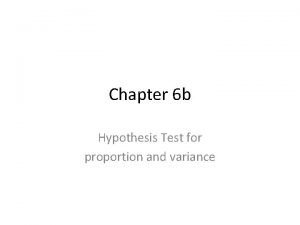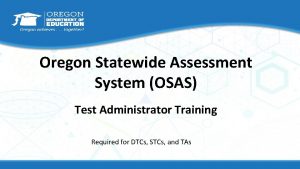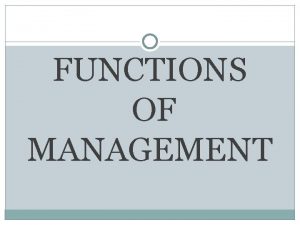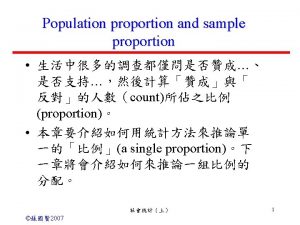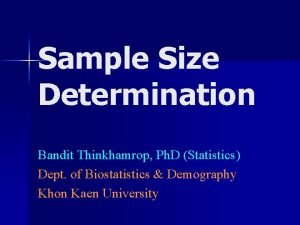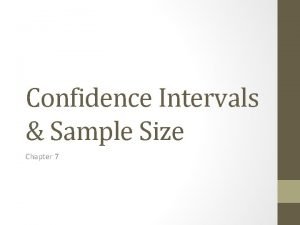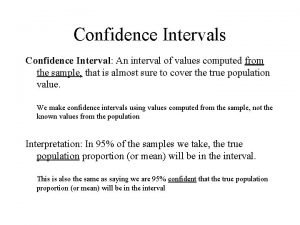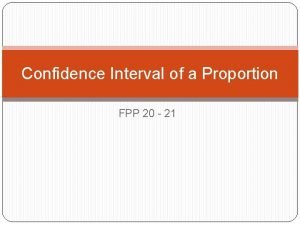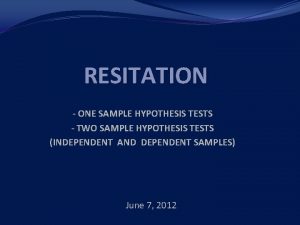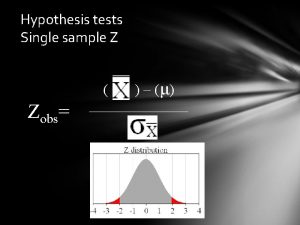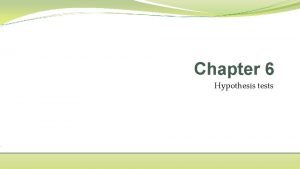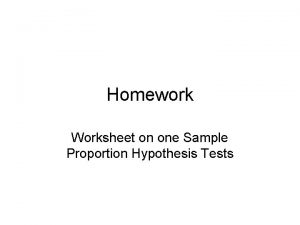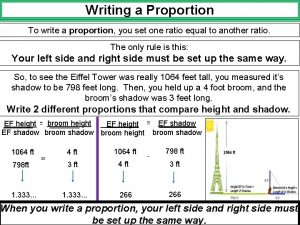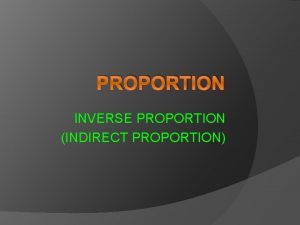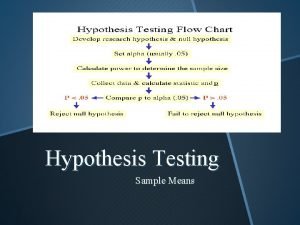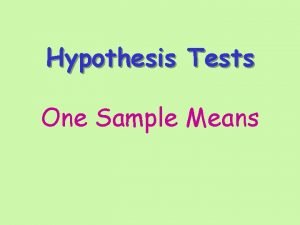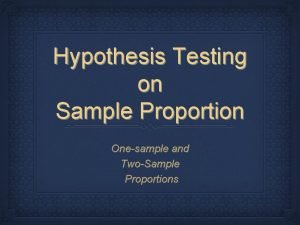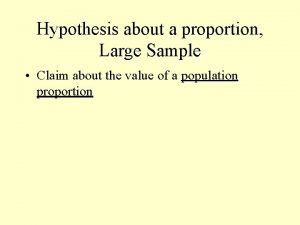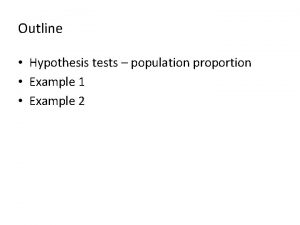Hypothesis Tests for 1 Sample Proportion Deciding whether



















- Slides: 19

Hypothesis Tests for 1 Sample Proportion

Deciding whether to “Reject” or to “Fail to Reject”… This decision can be made using two methods. • p-values: compare the p-value to the significance level • Critical values: compare the test statistic to the critical-value

P-values • Assuming H 0 is true, the probability that the statistic would have a value as extreme or more than what is actually observed In other words. . . is it far out in the tails of the distribution?

Level of significance • Is the amount of evidence necessary before we begin to doubt that the null hypothesis is true • Is the probability that we will reject the null hypothesis, assuming that it is true • Denoted by a • Can be any value • Usual values: 0. 1, 0. 05, 0. 01 • Most common is 0. 05

Statistically significant – • The p-value is as small or smaller than the level of significance (a) • If p-value > a, “fail to reject” reject the null hypothesis at the a level. • If p-value < a, “reject” reject the null hypothesis at the a level.

Facts about p-values: • ALWAYS make decision about the null hypothesis! • Large p-values show support for the null hypothesis, but never that it is true! • Small p-values show support that the null is not true. • Double the p-value for two-tail (=) tests • Never accept the null hypothesis!

Never “accept” the null hypothesis!

At an a level of. 05, would you reject or fail to reject H 0 for the given p-values? a). 03 b). 15 c). 45 d). 023 Reject Fail to reject Reject

Formula for hypothesis test:

Calculating p-values • For z-test statistic – • Use normalcdf(lb, ub) • Remember that z’s from the standard normal curve with m = 0 and s = 1

Draw & shade a curve & calculate the p-value: 1) right-tail test z = 1. 6 P-value =. 0548 2) two-tail test z = -2. 4 P-value =. 0164

Writing Conclusions: 1) A statement of the decision being made (reject or fail to reject H 0) & why (linkage) AND 2) A statement of the results in context. (state in terms of Ha)

“Since the p-value < (>) a, I reject (fail to reject) the H 0. There is (is not) sufficient evidence to suggest that Ha. ” Be sure to write Ha in context (words)!

Example 3 revisited: A new flu vaccine claims H 0: p =to. 7 prevent a certain type of flu in 70% of the people who are vaccinated. In H : p <. 7 a P-value = normalcdf(-10^99, -1. 38) =. 0838 a test, vaccinated people were exposed to Where is the true proportion the flu. p. The test statistic for of the results vaccinated people> who flu H. is Since the p-value a, I get fail the to reject 0 z. There = -1. 38. Is sufficient this claimevidence too high? is not to. Write suggest the calculate the people who thathypotheses, the proportion of vaccinated p-value & write the do not get the flu is less than 70%. Appropriate conclusion for a = 0. 05.

Let’s put all the steps together! Example 2 revisited: Is the proportion of people who think of the value 37 significantly higher than what we expect? Use a = 0. 05.

What confidence level would be equivalent to this right-tailed test with a = 0. 05? Calculate this confidence interval. How do the results from the confidence interval compare to the results of the hypothesis test?

Example 5: A company is willing to renew its advertising contract with a local radio station only if the station can prove that more than 20% of the residents of the city have heard the ad and recognize the company’s product. The radio station conducts a random sample of 400 people and finds that 90 have heard the ad and recognize the product. Is this sufficient evidence for the company to renew its contract?

Assumptions: • Have an SRS of people • np = 400(. 2) = 80 & n(1 -p) = 400(. 8) = 320 - Since both are greater than 10, this distribution is approximately normal. • Population of people is at least 4000. Use the parameter in the null hypothesisof to people check assumptions! H 0: p =. 2 where p is the true proportion who Ha: p >. 2 heard the ad Use the parameter in the null hypothesis to calculate standard deviation! Since the p-value > a, I fail to reject the null hypothesis. There is not sufficient evidence to suggest that the true proportion of people who heard the ad is greater than. 2. The company will not renew their advertising contract with the radio station.

Calculate the appropriate confidence interval for the above problem. CI = (. 19066, . 25934) How do the results from the confidence interval compare to the results of the hypothesis test? The confidence interval contains the parameter of. 2 thus providing no evidence that more than 20% had heard the ad.
 Iq intelligence
Iq intelligence Whether the weather be fine
Whether the weather be fine Hypothesis testing for population proportion
Hypothesis testing for population proportion Oregon test portal
Oregon test portal Eqao practice test grade 3
Eqao practice test grade 3 Deciding to marry asl story
Deciding to marry asl story Perencanaan menurut newman
Perencanaan menurut newman Planning is deciding in advance what is to be done
Planning is deciding in advance what is to be done Deciding on the global marketing organization
Deciding on the global marketing organization Flexible time culture
Flexible time culture What was the sickening comic aspect
What was the sickening comic aspect What is a null hypothesis
What is a null hypothesis Developing null and alternative hypothesis
Developing null and alternative hypothesis Null hypothesis and alternative hypothesis examples
Null hypothesis and alternative hypothesis examples Protoplanet hypothesis weakness
Protoplanet hypothesis weakness Ratio and direct proportion
Ratio and direct proportion Sample size for proportion formula
Sample size for proportion formula How to find sample size
How to find sample size Confidence interval for sample proportion
Confidence interval for sample proportion Confidence interval for sample proportion
Confidence interval for sample proportion


